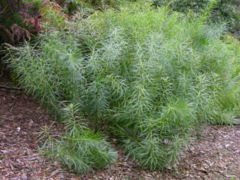Amsonia
| Amsonia subsp. var. | ||||||||||||||||||||||||||||||||||||||||||||||||||||||||
|---|---|---|---|---|---|---|---|---|---|---|---|---|---|---|---|---|---|---|---|---|---|---|---|---|---|---|---|---|---|---|---|---|---|---|---|---|---|---|---|---|---|---|---|---|---|---|---|---|---|---|---|---|---|---|---|---|

|
|
| ||||||||||||||||||||||||||||||||||||||||||||||||||||||
| ||||||||||||||||||||||||||||||||||||||||||||||||||||||||
The Bluestar (Amsonia) is a genus in the family Apocynaceae.
| Standard Cyclopedia of Horticulture |
|---|
|
Amsonia, (named for Charles Amson, colonial physician in eighteenth century). Called also Ansonia. Apocynacese. Plants sold for border planting, mostly among shrubbery, but little known in cultivation. Tough-barked perennial herbs with alternate narrow lvs. and terminal panicles of blue or bluish narrow- limbed small fls. in May and June, the inside of the corolla-tube bearing reflexed hairs and also the 5 stamens: fr. two long and slender many-seeded follicles.— About a dozen species in E. U. S. and E. Asia. Prop, mostly by dividing the clumps; also by seeds, and by cuttings in summer.
|
Cultivation
Propagation
Pests and diseases
Species
- Amsonia ciliata - Fringed Bluestar
- Amsonia elliptica - Japanese Bluestar
- Amsonia fugatei - San Antonio Bluestar
- Amsonia grandiflora - Arizona Bluestar
- Amsonia hubrichtii - Hubricht's Bluestar
- Amsonia illustris - Ozark Bluestar
- Amsonia jonesii - Jones' Bluestar
- Amsonia kearneyana - Kearney's Bluestar
- Amsonia longiflora - Tubular Bluestar
- Amsonia ludoviciana - Louisiana Bluestar
- Amsonia orientalis - European Bluestar
- Amsonia palmeri - Palmer's Bluestar
- Amsonia peeblesii - Peebles' Bluestar
- Amsonia repens - Creeping Bluestar
- Amsonia rigida - Stiff Bluestar
- Amsonia tabernaemontana - Eastern Bluestar
- Amsonia tharpii - Feltleaf Bluestar
- Amsonia tomentosa - Woolly Bluestar
Gallery
-
photo 1
-
photo 2
-
photo 3
References
- Standard Cyclopedia of Horticulture, by L. H. Bailey, MacMillan Co., 1963
External links
- w:Amsonia. Some of the material on this page may be from Wikipedia, under the Creative Commons license.
- Amsonia QR Code (Size 50, 100, 200, 500)
